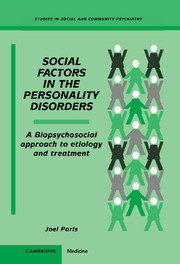Book contents
- Frontmatter
- Contents
- Foreword
- Introduction
- Acknowledgments
- 1 Overview
- 2 Personality Traits and Personality Disorders
- 3 Biological Factors
- 4 Psychological Factors
- 5 Social Factors – Methods
- 6 Social Factors – Mechanisms
- 7 A Biopsychosocial Model of the Personality Disorders
- 8 The Odd Cluster
- 9 The Impulsive Cluster
- 10 The Anxious Cluster
- 11 Treatment
- 12 Clinical Practice
- Epilogue: Summary and Research Implications
- References
- Index
6 - Social Factors – Mechanisms
Published online by Cambridge University Press: 05 May 2010
- Frontmatter
- Contents
- Foreword
- Introduction
- Acknowledgments
- 1 Overview
- 2 Personality Traits and Personality Disorders
- 3 Biological Factors
- 4 Psychological Factors
- 5 Social Factors – Methods
- 6 Social Factors – Mechanisms
- 7 A Biopsychosocial Model of the Personality Disorders
- 8 The Odd Cluster
- 9 The Impulsive Cluster
- 10 The Anxious Cluster
- 11 Treatment
- 12 Clinical Practice
- Epilogue: Summary and Research Implications
- References
- Index
Summary
In the present chapter, we will suggest mechanisms by which social factors could either increase or decrease the risk for developing personality disorders. If the frequency of personality traits varies from one society to another, then the frequency of the disorders associated with these dimensions should vary accordingly. Therefore, in the first section, we will consider to what extent social factors can shape traits. In the second section, we will focus on mechanisms by which social factors could lower the thresholds for traits to develop into disorders.
We can only understand the influence of social factors, on either traits or disorders, in the context of social structures. Social scientists have many constructs to classify these structures, but at this point, we will introduce one basic distinction, which will pervade all the arguments to be made later.
Traditional and modern societies
Social structures can be dichotomized into “traditional” or “modern” types (Lerner, 1958; Inkeles & Smith, 1974). We can best understand this distinction from a historical perspective. Traditional societies are primarily characterized by slow rates of social change and by intergenerational continuity. Modern societies, in contrast, are characterized by rapid social change and by intergenerational discontinuity.
There are, of course, important differences between the traditions of all the societies that might be classified as “traditional”. What we will argue here is that whatever the specific nature of traditions, they provide individuals with a set of predictable expectations.
- Type
- Chapter
- Information
- Social Factors in the Personality DisordersA Biopsychosocial Approach to Etiology and Treatment, pp. 73 - 94Publisher: Cambridge University PressPrint publication year: 1996



